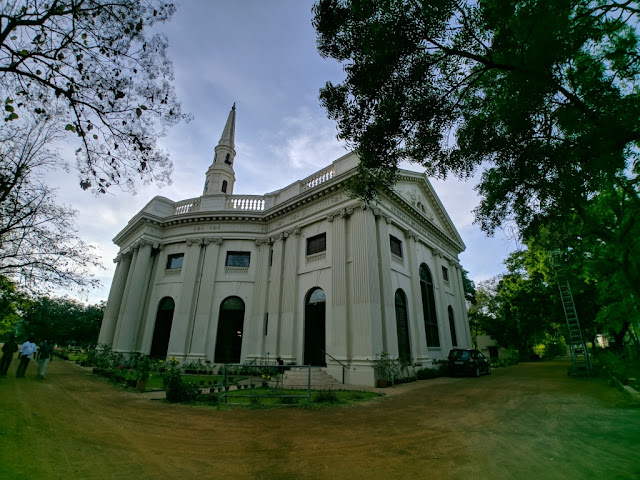St Andrew's Church, Egmore – Architecture
St Andrew's Church is one of the finest examples of
Georgian Church architecture in Asia. The church shows prominent features of
Neo-Classical architecture, it is inspired by St Martin in the fields in
London. It was designed and executed by Major Thomas de Havilland and Colonel
James Caldwell of the Madras Engineers. The land was purchased because of the
low land value and its proximity to the Fort St. George. But the land was on
marshy lowland and was subject to sinking and flooding.
The 14 ft foundation of the Kirk sits on a bed of
pottery and brick wells 9 ft deep. The wells were sunk into the marshy sand by
first weaving a wicker ring to sit under the brick or pottery ring. The walls
of the well were built with specially made curved bricks or pottery rings
cemented with watery mortar over it. The entire tube was then bound completely
with coir rope. The well digger gets into this tube to excavate the hole
beneath, taking utmost care not to upset the perpendicularity of the
constructed cylinder.
The total of 150 wells were set close to each other and
were filled with material whose volume did not alter in water. The foundation
was created as a strong series of connected low vaults that could serve as
catacombs if necessary in the future. The building was kept in equilibrium as
all the wells were placed on the same type of surface and would all be affected
uniformly.
On the April 6, 1818, Rev. Doctor John Allen D.D laid
the foundation stone of the church. The circular central congregation hall is
cool and airy. The beauty and grace of the church is by lovely stuccowork
of Madras Chunnambu or lime stucco renowned for its superiority. The pillars
and walls are decorated with a relief of grapes nestled in leaves.
Dome:
The body of the church is a circle, with rectangular
compartments to the east and west. The circular part 24.5 m in diameter, was
constructed using the 'Syrian masonry' technique. The dome was painted with
lapis lazuli shade of blue. It is believed to be one of the few in the world to
be supported by columns of such huge height. This is painted with golden stars
and supported by 16 fluted pillars with Corinthian columns support it.
The interiors are done with woodwork of mahogany and
black and white chequered marble floor, which adds to the beauty of this
church. A narrow stairway leads to the roof of the main structure. There is the
bald top of the dome. Two new stainless-steel bands reinforce the dome, which
had begun to crack. At the front end is the steeple itself.
Stained Glass:
The stained-glass windows above the main altar, in warm,
rich colors, are among the glories of the church. The two enormous
stained-glass panels glow on the back wall depicting scenes from the Bible. The
breathtakingly rich glass stained window panels of St. Peter and St. Andrew are
examples of excellent artistry by 'W&J Jkier, artists in Stained Glass,
Glasgow, Scotland'.
Pipe Organ:
The church boasts of one of the oldest pipe organs in
the city of Chennai. Maestros like Handel Manuel and Victor Paranjothi have led
the gifted choir of this church renowned for its beauty and
song. Dominating the altar is the pipe organ in dull green and burnished
gold. Built in New Yorkshire, England, this instrument was installed in 1883.
15 enormous olive green and gold pipes are arranged in a beautiful vertical and
lateral pattern to make an astounding organ. Behind the pipes, connected mass
of levers, hinges, pipes, chords and beams are placed that made this complex
instrument work.
Bell:
A bell is suspended from a large beam in a square room
having a beautiful sound. An interesting story is associated with the bell. The
original bell was 4 m in diameter and was meant especially for this Church. It
was cast by an experienced bell founder from Bengal, in a Powder foundry, which
is otherwise used only for military purpose. The British bureaucracy had,
however, refused to spare the founder of the establishment to cast the bell.
The bell was duly hung and tolled for the first time at
the funeral of the aged pastor. Very soon a controversy surrounded the bell,
following the complaint by the jealous powder – mill founder who was sidelined
from this project. The bell was brought down, and the Military Board ordered an
inquiry. The bell was ordered to be sold and was broken up and replaced by the
existing one.



















